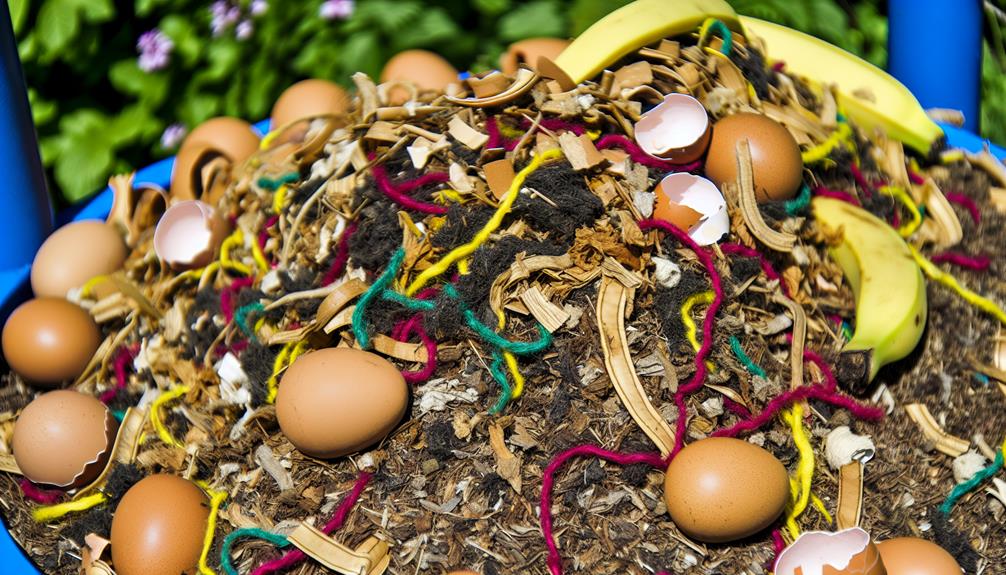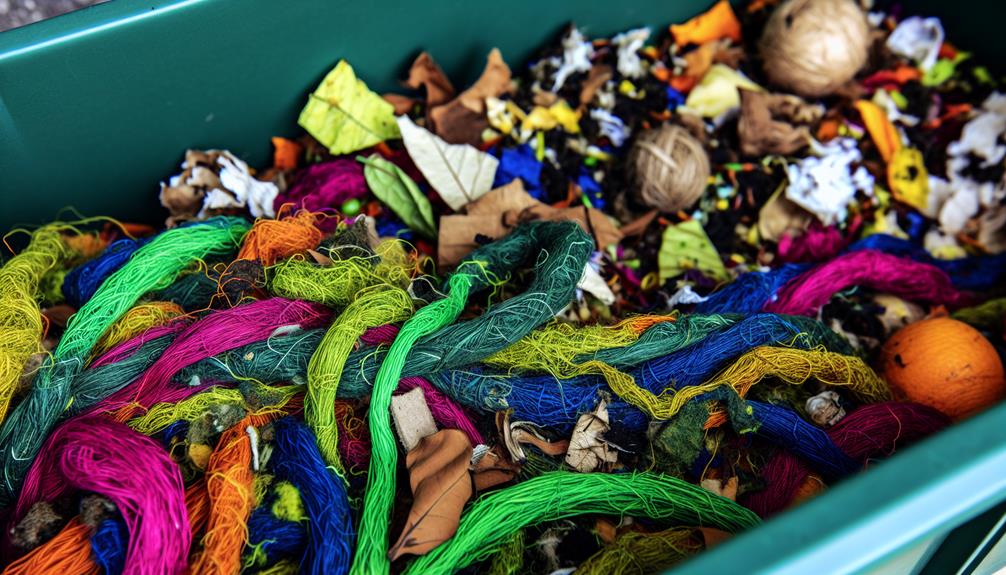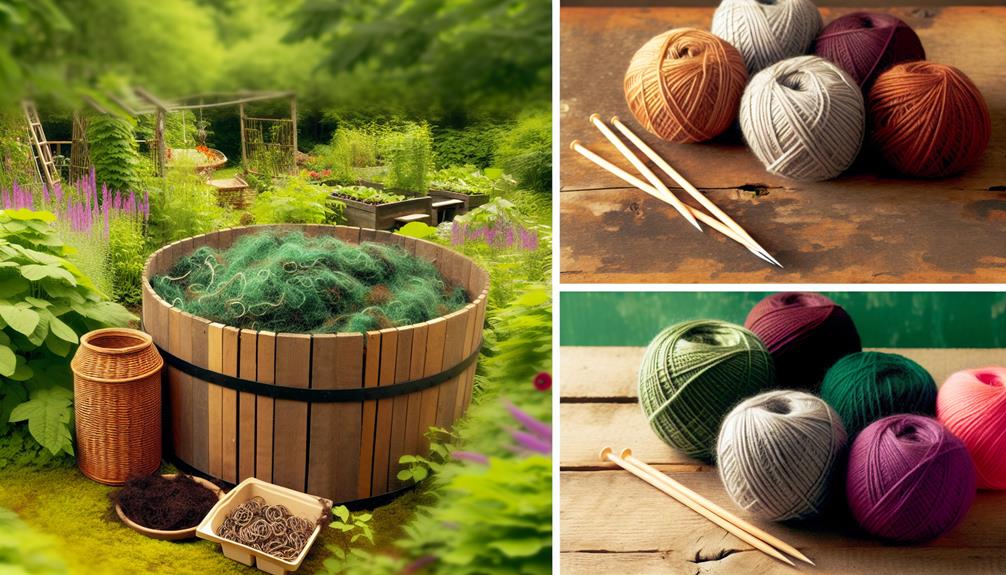

You can compost yarn, but it depends on its material. Natural fiber yarns like cotton, wool, and bamboo decompose well and enrich your soil. However, avoid composting synthetic yarns such as acrylic and polyester, as they resist biodegradation and can contribute to microplastic pollution.
To compost natural yarn effectively, cut it into small pieces, mix it with green and brown materials, and maintain proper moisture and aeration in your compost pile. Consider using eco-friendly alternatives like recycled or organic yarn to further reduce environmental impact. Curious about managing different yarn types in your compost?
When you’re selecting yarn for composting, it’s important to understand the different types available. This knowledge helps you make informed choices that benefit your composting efforts and crafting projects.
Yarn comes in various materials, each with unique properties affecting its compostability. Synthetic yarns, like acrylic and polyester, are known for their yarn durability but aren’t biodegradable. These yarns resist breaking down, making them unsuitable for composting.
On the other hand, yarns made from natural fibers are more compost-friendly but vary in how they decompose.
Your crafting techniques also play a role in the composting process. Techniques that result in looser, more open stitches create yarn fragments that break down more easily. Tighter stitches or densely crafted items take longer to decompose. Consider using simpler patterns and looser stitches if you plan to compost your yarn scraps.
Additionally, blending different yarn types can complicate composting. Mixed-material yarns, such as those combining synthetic and natural fibers, pose a challenge because the synthetic components won’t break down. Stick to 100% natural fiber yarns for the best composting results.
Also Read: Can You Compost Artichoke?
Natural fibers, such as cotton, wool, and bamboo, offer excellent compostability due to their biodegradable nature. When you compost yarn made from these fibers, you’re contributing to a more sustainable environment. Yarn recycling through composting guarantees that these natural materials break down efficiently, returning valuable nutrients to the soil.
To compost natural fiber yarn effectively, consider these steps:
When you recycle yarn through composting, you’re not just reducing waste; you’re also enriching your compost with natural fibers that decompose seamlessly. This means less landfill waste and a healthier garden.
Dealing with synthetic fibers in composting can be challenging due to their resistance to biodegradation. When you add synthetic yarns like polyester or nylon to your compost, you’re introducing materials that won’t break down like natural fibers do. These fibers can persist in the environment for years, contributing to microplastic pollution.

To manage your waste effectively, it’s essential to identify and separate synthetic fibers from your compostable materials. Synthetic yarns don’t decompose; instead, they break into smaller pieces, leading to microplastics that can contaminate soil and water. This not only undermines the quality of your compost but also poses a risk to the broader ecosystem.
For a more sustainable approach to waste management, consider alternatives to synthetic yarns, such as those made from natural fibers or recycled materials. If you must dispose of synthetic yarns, it’s better to follow your local waste management guidelines, which might include recycling or proper landfill disposal.
Also Read: Can You Compost Barbecue Sauce?
To start composting effectively, you need to understand the basic steps and principles involved in the process. Composting isn’t just about throwing organic waste into a pile; it’s about creating the right conditions for decomposition. You’ll need to balance green materials (rich in nitrogen) and brown materials (rich in carbon) to guarantee a healthy compost environment.
Here are the key steps to follow:
Also Read: Can You Compost Basil?
When you’re looking to reduce your environmental impact, consider eco-friendly alternatives that can complement your composting efforts. One great option is using recycled yarn.

Recycled yarn is made from pre-used fibers, which means it requires less energy and fewer resources to produce. By choosing recycled yarn, you not only divert waste from landfills but also support a more sustainable textile industry.
Additionally, pay attention to green packaging. Many yarn brands are now adopting eco-friendly packaging solutions, such as biodegradable or recyclable materials. This not only reduces the waste associated with packaging but also aligns with your overall goal of sustainability.
Here’s a quick comparison to help you understand the benefits:
| Eco-Friendly Alternatives | Advantages |
|---|---|
| Recycled Yarn | Reduces waste, saves energy |
| Green Packaging | Less waste, eco-friendly |
| Organic Yarn | No harmful chemicals |
| Natural Dyes | Biodegradable, non-toxic |
When you compost yarn fibers, soil bacteria break them down, enriching the soil. You’ll create a community of thriving microorganisms, enhancing soil quality and promoting healthier plants. Join others who are making a sustainable difference!
Yes, you can compost natural fibers like wool or cotton yarn, but avoid synthetic yarns. Dyed natural fibers might contain chemicals that aren’t compostable. Join a community garden and share your composting tips for better soil.
When considering health concerns with composting yarn, you’ve got to watch for microfiber pollution from synthetic fibers. It’s important to stick with natural fibers to keep your compost safe and eco-friendly for the community.
You’ll know yarn’s decomposing properly when you see consistent moisture levels and fungal growth. It bonds with the compost community, breaking down into rich, organic matter. Feeling connected to nature’s cycle is truly satisfying!
Yes, composting yarn can result in pest infestation if not conducted properly. To guarantee effective rodent control, always mix yarn with other compost materials and maintain a balanced compost pile. Your community’s efforts will thrive!
You can compost yarn if it’s made from natural fibers like cotton or wool, but avoid synthetic fibers like polyester.
Cut the yarn into small pieces to speed up decomposition.
For eco-friendly alternatives, consider using organic yarn or recycled materials.
Always verify labels to make sure your yarn is biodegradable.
By making informed choices, you’ll reduce waste and contribute to a more sustainable environment.
Happy composting!
